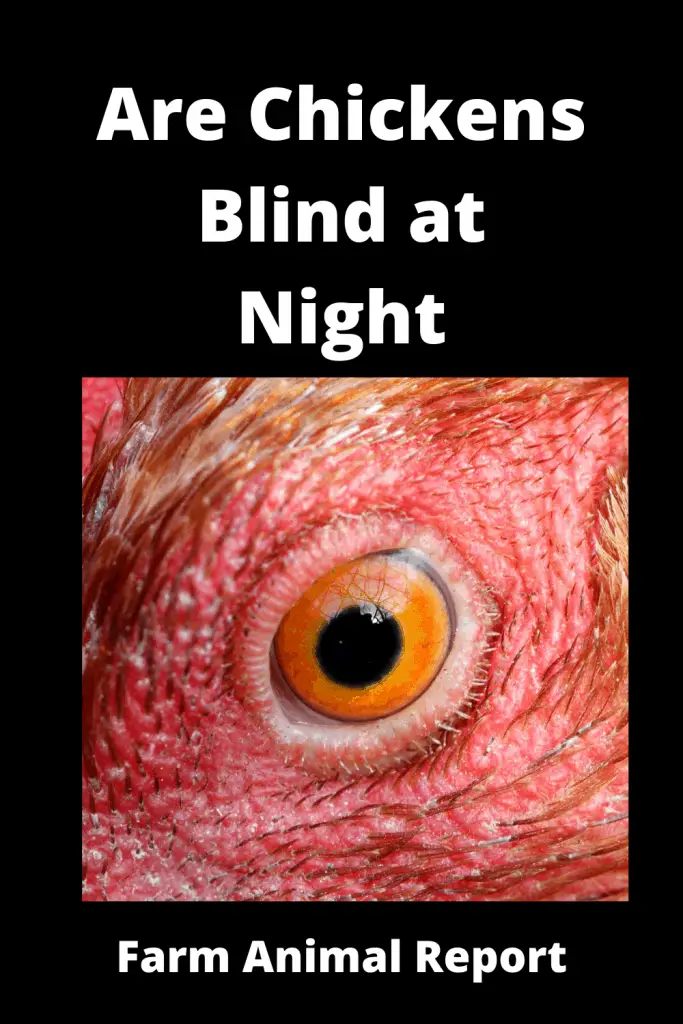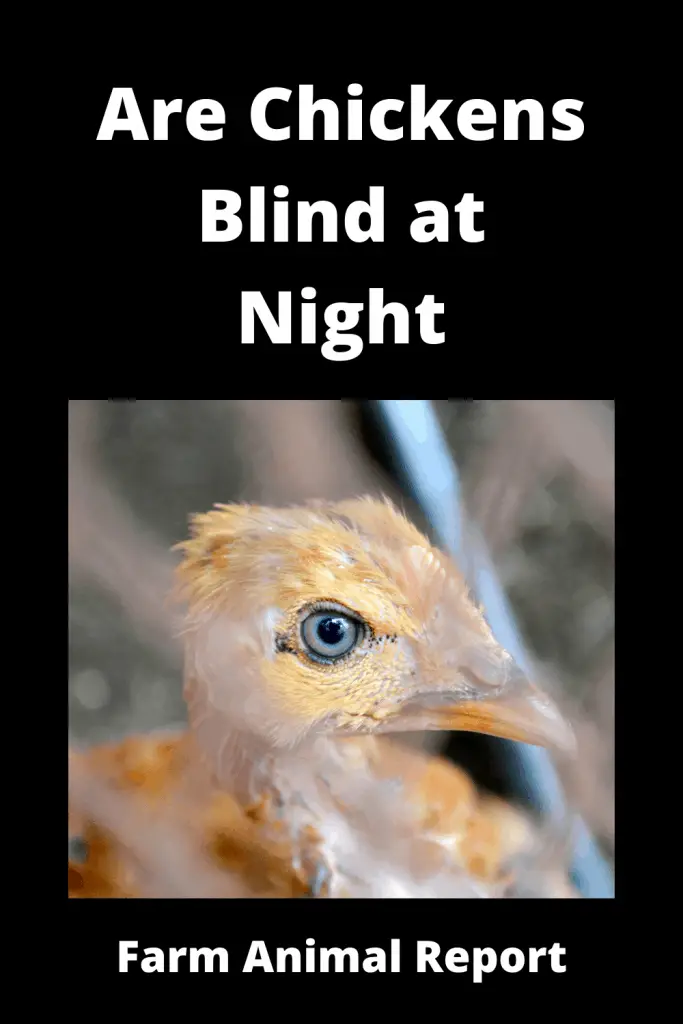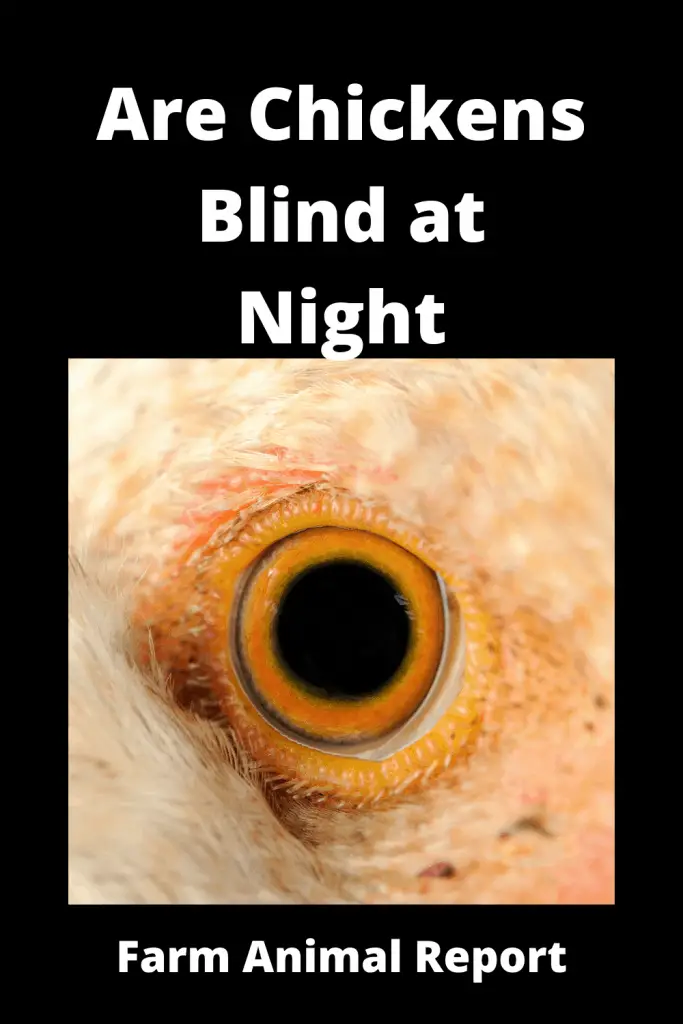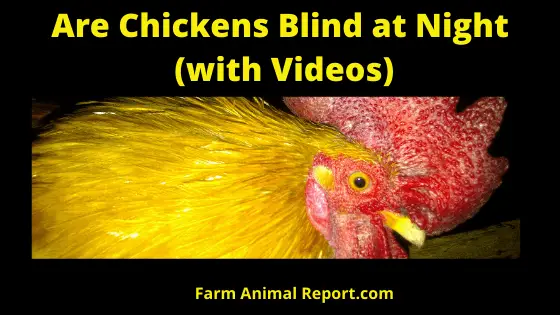Can Chickens see in the Dark – As a general rule Chickens really can’t see very well at night. In fact, they are often referred to as having night blindness. There is some science to back up the fact that chickens do not have as good vision as we do at night, which isn’t great. And they certainly can’t see as well as nocturnal animals. While chickens have excellent color vision, they do not have excellent night vision.
Can Chickens see in the Dark/ Blindness / Night Time Routine
Can Chickens see in the Dark – This is a form of vision impairment that means someone or something has a very poor vision at night. This is because anyone who has owned chickens will have seen how they behave when it’s dark. For the most part, they just roost and sleep. If you approach a chicken when it’s dark, they act very nervous and don’t make good eye contact.

Can chickens see in the dark – Often just going limp if you handle them, this is because they can’t see what’s happening so it’s pretty scary for them. Night-vision requires light-sensitive photoreceptors in the retina called rods. We have around 120 million rods in our eyes, while chickens have far fewer.
12 Ways to Make Money by Chicken Farming—Extensive Guidelines for Chicken Farmers
As unlikely as it seems to look at them, chickens and birds, in general, are believed to be descendants of dinosaurs. While most mammals were nocturnal during the dinosaur period, birds and dinosaurs were not. Hence, why they have evolved to have excellent day vision and poor night vision.
Paragraph For Amazon Resources for Raising Meat Chickens
Night-vision relies on light-sensitive photoreceptors in the retina called rods, while daytime vision relies on receptors called cones. During the age of the dinosaurs, most mammals became nocturnal for millions of years. Birds, now widely believed to be descendants of dinosaurs, never spent a similar period as nocturnal animals.
As a result, birds have more types of cones than mammals The human retina has cones sensitive to red, blue and green wavelengths, Avian retinas also have a cone that can detect violet wavelengths, including some ultraviolet, and a specialized receptor called a double cone that we believe helps them detect motion.
In addition, most avian cones have a specialized structure that compares to cellular sunglasses, or a lens-like drop of oil within the cone that is pigmented to filter out all but a particular range of light. Researchers used these drops to map the location of the different types of cones on the chicken retina. While the different types of cones were evenly distributed throughout the retina, no two cones of the same type were located next to each other.
This is the ideal way to uniformly sample the color space of your field of vision. It appears to be a global pattern created from a simple localized rule.
Structure of Chicken Eyes ( Night Time Routine) Night
The chicken can also see into the ultraviolet but the differences don’t stop there. Chicken (and other birds) eyes are actually far more sophisticated than those of mammals. They have cones to detect color as we do but they have enhancements. They also have minute drops of colored oil that filter out different wavelengths – yellow, blue, and red.
This actually gives the bird enhanced contrast, brightness, and sensitivity. As if that wasn’t enough, their eyes are more sensitive to movement than our eyes. They have a structure called a double cone for that as part of their retina. The last advantage the chicken’s eye has over our eyes is that we only have one fovea but the chicken has two. The fovea is the spot in our eye that the lens focuses on and is most sensitive.

Your hen has one for long-distance and another for close-ups! You might notice that when they’re focusing on something near, they move their heads. That’s because they’re using their close-up vision. Now before you develop an inferiority complex, our vision is superior in one way. We see better in the dark. We have a higher percentage of rods to cones in our eyes and bigger eyes to collect more light.
Chickens Have Infra-red Vision
At the other end of the spectrum from ultraviolet is infra-red which is basically heat radiation. Infrared is used by anti-aircraft missiles to home in on the hot engines.
Neither birds nor mammals can ‘see’ in infra-red but snakes have sensitive pits on their heads that help them find warm-blooded creatures by detecting infra-red heat radiation.
Chickens / VS / The Predator (chicken coop)
Famously the alien in the film Predator could see in different wavelengths but primarily in infra-red.
What Does the World Look like to a Chicken?
Basically, this is something we can’t know. Possibly in the future people may have artificial eyes that sense a wider spectrum than natural eyes but that’s science fiction. It’s probable that the world is a richer place visually to your hen. Because of her wide spectrum, things that appear identical to us may be very different from the hen.
The sky most likely looks very different from a chicken with brightness showing the sun’s position even on a cloudy day. She may well see rodent urine trails and certainly would pick up something scuttling through the undergrowth better than us. Chickens have Terrible Night Vision

The differences don’t stop with colors chickens have a wider field of vision than we do. What they see is a bit like a wide-angle camera lens but they have a narrower central focus. Their eyes don’t move as freely as ours do which is why they move their whole head to see better. Chickens can see directly ahead – usually a trait of predators so they can use stereoscopic vision to judge distance when hunting.
But their eyes are further around their head than our eyes. That’s usually a trait of herbivores to give them warning of carnivores sneaking upon them. The chicken’s brain will integrate these two views so they have a warning of predators sneaking upon them. The only area they won’t at least detect movement in is directly behind their head.
Facts Related to Chickens’ Eyes
You probably did not give much of a thought to this matter, but here are some interesting facts that might grab your attention next time when you see a chicken.
- Chickens and colors – As opposed to the human vision, a chicken does not have only three basic colors – blue, red, and yellow – it also possesses a cone for the ultra-violet light. This is an interesting system that allows it to make differences between certain objects which are seen in far more colors and shades than humans manage to distinguish them.
- The UV cones – The cones that are specially designed for the UV light help chickens spot any shiny bugs and insects that might walk around. Also, any seeds and fruits that can be reflected really easy on the dirt or grass. An interesting fact would be the usage of the cones of a mother hen in order to detect which of the chicks are the healthiest ones. This happens due to the fact that the feathers reflect the UV light and the hen can easily determine which of the chicks are growing faster and stronger. This will make her devote her energy towards the healthy ones since they have a better chance of surviving compared to the weaker chicks.
- Chickens and motion – Besides the UV cone, chickens also have a motion detector located right in their eyes. Therefore, it is extremely easy for them to notice slight movements whether it’s a potential prey or a predator.
- The night vision – Chickens are known to have evolved after the dinosaur era has passed. They are connected to their ancestors but unlike other species which had to spend their lives in the dark, their night vision is quite under-developed. Their retina allows a low sensitivity to light.
- The eyelids – Compared to the human eye which has a superior and an inferior eyelid, a chicken’s eye will have three eyelids. The third one can be seen as a protective sheet against dust and other damaging particles. It is transparent and it is also located across the eye. It is used only when the chicken is bathing or foraging in the dirt.
- Chicks and their vision – A surprising event take place right before hatching when the soon to be born chicks will turn in the shell, their right eye would be located right near the shell. Thus, absorbing the light much better, while the left eye is covered by its body. The consequence of this action is reflected in the fact that the right eye will develop a proximity vision much better than the left one which will be used for seeing things in the distance. Long story short, the right eye is going to be used in the search of food, while the left one is going to be used for observing predators from far.
- The pineal gland – This is an important element in every chicken’s anatomical structure, as it helps them sense the presence or the absence of the light. As a consequence, even a blind chicken will sense whether it is daytime or nighttime outside or if the seasons are shifting. It all happens due to the pineal gland.
Chicken / Poultry Breeder Associations
| Rabbit Association | Location | Link |
|---|---|---|
| US Poultry & Egg Association | United States | USPA |
| American Poultry Association | California | APA |
| Ohio Poultry Association | Ohio | OPA |
| National Chicken Council | United States | NCC |
| British Poultry Council | United Kingdom | BPCE |
| Poultry Club of Great Britain | United Kingdom | PCGB |
| Association of Poultry Breeders in EU | Europe | AVEC |
| Australian Chicken Meat Federation Inc | Australia | ACMF |
| Australian Poultry Hub | Australia | Poultry Hub |
Other Important Tags
- a chicken doesn’t have night vision which enables them to see in
- chickens can’t see anything in the dark unless artificial
- chickens see colors better than we do
- chickens cannot see in the dark
- can chickens see at night
- What can chickens see
- chickens make noise
- night chickens make
- lack night vision
- night time routine
Final Thoughts
Chickens are not Blind at night. They can see in the dark but not very well. Above is a detailed explanation of a chicken’s eyes and their abilities. Their Vision is poorer than ours during the night. Their eyes are highly developed but for Daylight eyesight, their eyes are very acute.





